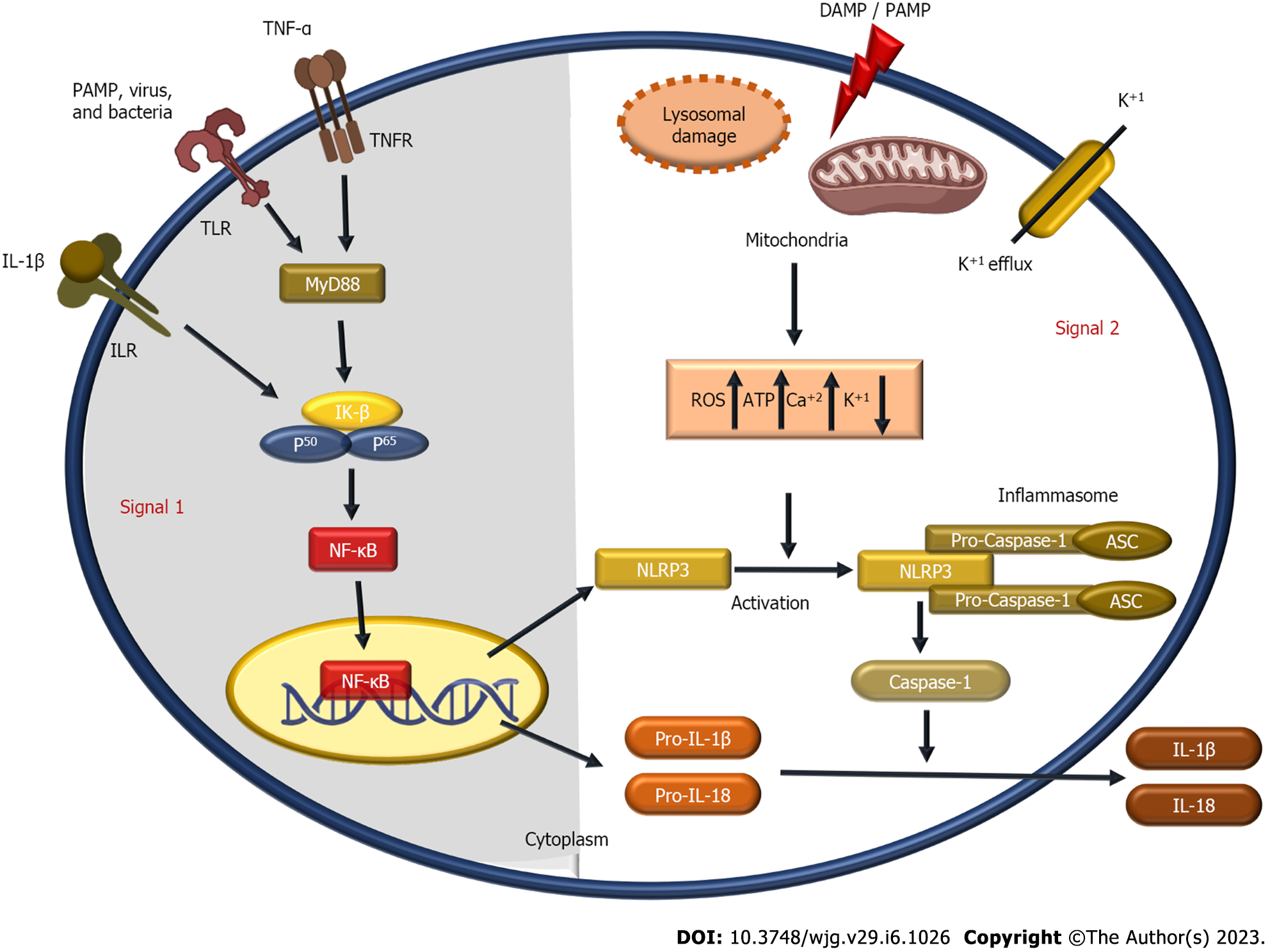Copyright
©The Author(s) 2023.
World J Gastroenterol. Feb 14, 2023; 29(6): 1026-1053
Published online Feb 14, 2023. doi: 10.3748/wjg.v29.i6.1026
Published online Feb 14, 2023. doi: 10.3748/wjg.v29.i6.1026
Figure 1 Inflammatory response inside the colon in inflammatory bowel diseases including ulcerative colitis.
Several inflammatory pathways are involved in ulcerative colitis (UC), which result in increased inflammatory mediators and cytokines and subsequent activation of inflammatory cells. First, activation of Toll-like receptors (TLR) by pathogen associated molecular pattern (PAMP), bacteria and viruses as well as tumor necrosis factor-alpha receptor (TNFR) stimulation by TNF-α, induce nuclear factor-κB (NF-κB) translocation through upregulation of MyD88 and IK-β, P50, and P65 complex. Second, along with NF-κB upregulation, interleukin receptor stimulation by interleukin (IL)-1β and/or IL-6 activates signal transducer and activator of transcription 3 signalling activation. Third, damage associated molecular pattern and/or PAMP are stimulates mitochondria to generates reactive oxygen species (ROS) which enhances inflammatory response through NF-κB activation whereas activating nuclear factor erythroid 2-related factor 2 signalling by ROS suppresses the inflammatory response by blocking NF-κB signalling and inducing antioxidants that downregulates ROS. IBDs: Inflammatory bowel diseases; UC: Ulcerative colitis; IL-(1β): Interleukin-1 beta; DAMP: Damage associated molecular pattern; PAMP: Pathogen associated molecular pattern; TNF-α: Tumour necrosis factor-alpha; ILR: Interleukin receptor; TLR: Toll-like receptor; TNFR: Tumour necrosis factor receptor; MyD88: Myeloid differentiation primary response 88; IK-β: Inhibitor kappa-beta; P50: Nuclear factor-kappa B P50 subunit; P65: Nuclear factor-kappa B P65 subunit; ROS: Reactive oxygen species; STAT3: Signal transducer and activator of transcription 3; NF-κB: Nuclear factor-kappa B; Nrf2: Nuclear factor erythroid 2-related factor.
Figure 2 The mechanism of nod-like receptor protein-3 inflammasome activation.
Nod-like receptor protein-3 (NLRP3) inflammasome activation occurs through two signals, (signal 1) toll-like receptor stimulation by pathogen associated molecular pattern (PAMP), bacteria and viruses, tumour necrosis factor receptor stimulation by TNF-α, and interleukin receptor (ILR) stimulation by IL-1β leads to activation of nuclear factor-kappa B (NF-Κb) via upregulation of MyD88, and Iκ-β, P50, and P65 complex. Pro-IL-1β, pro-IL-18, and inactive NLRP3 expression were all increased by the translocation of activated NF-κB into the nucleus. (Signal 2) Increased intracellular reactive oxygen species, adenosine triphosphate, and Ca+ levels are caused by damage associated molecular pattern and PAMP-induced lysosomal damage, and mitochondrial dysfunction, while K+ efflux lowered intracellular K+ level. The previous intracellular events lead to activates NLRP3 to inflammasome that promotes caspase-1 which begin to convert pro-IL-1β and pro-IL-18 into IL-1β and IL-18. IL-(1β): Interleukin-1 beta; DAMP: Damage associated molecular pattern; PAMP: Pathogen associated molecular pattern; TNF-α: Tumour necrosis factor-alpha; ILR: Interleukin receptor; TLR: Toll-like receptor; TNFR: Tumour necrosis factor receptor; MyD88: Myeloid differentiation primary response 88; IK-β: Inhibitor kappa-beta; P50: Nuclear factor-kappa B P50 subunit; P65: Nuclear factor-kappa B P65 subunit; ROS: Reactive oxygen species; ATP: Adenosine triphosphate; Ca+: Calcium ion; K+: Potassium ion; NF-Κb: Nuclear factor-kappa B; NLRP3: Nod-like receptor protein-3; ASC: Apoptosis-associated speck-like protein.
- Citation: Ali FE, Ibrahim IM, Ghogar OM, Abd-alhameed EK, Althagafy HS, Hassanein EH. Therapeutic interventions target the NLRP3 inflammasome in ulcerative colitis: Comprehensive study. World J Gastroenterol 2023; 29(6): 1026-1053
- URL: https://www.wjgnet.com/1007-9327/full/v29/i6/1026.htm
- DOI: https://dx.doi.org/10.3748/wjg.v29.i6.1026










